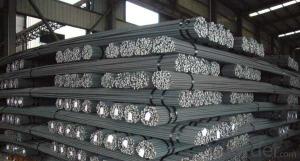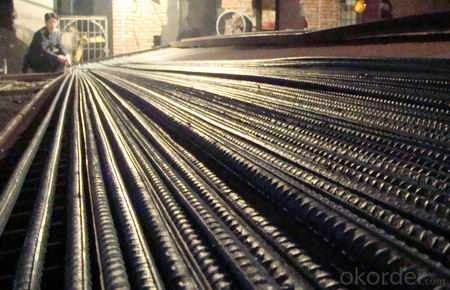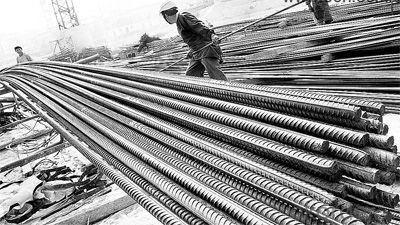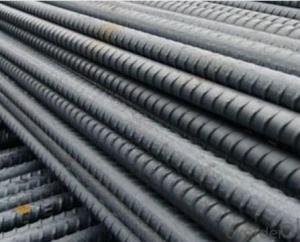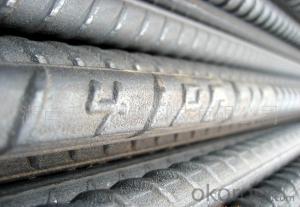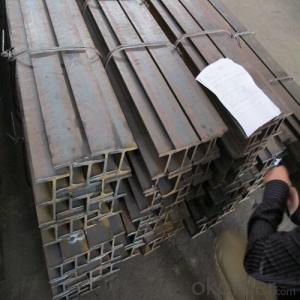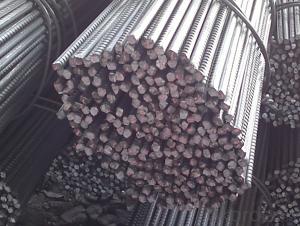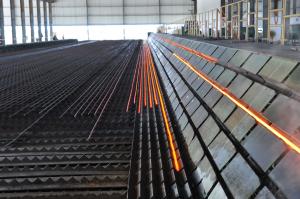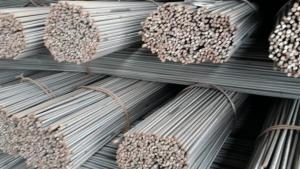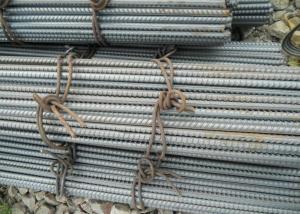A615 deformed steel bar deformed steel bar
- Loading Port:
- Tianjin
- Payment Terms:
- TT or LC
- Min Order Qty:
- 25 m.t.
- Supply Capability:
- 100000 m.t./month
OKorder Service Pledge
OKorder Financial Service
You Might Also Like
Product Description:
OKorder is offering high quality Hot Rolled Steel I-Beams at great prices with worldwide shipping. Our supplier is a world-class manufacturer of steel, with our products utilized the world over. OKorder annually supplies products to European, North American and Asian markets. We provide quotations within 24 hours of receiving an inquiry and guarantee competitive prices.
Product Applications:
Hot Rolled Steel I-Beams are ideal for structural applications and are widely used in the construction of buildings and bridges, and the manufacturing, petrochemical, and transportation industries.
Product Advantages:
OKorder's Steel I-Beams are durable, strong, and resist corrosion.
Main Product Features:
· Premium quality
· Prompt delivery & seaworthy packing (30 days after receiving deposit)
· Corrosion resistance
· Can be recycled and reused
· Mill test certification
· Professional Service
· Competitive pricing
Product Specifications:
Packaging & Delivery
| Packaging Detail: | In bundles (standard export package or as per clients' requirement) |
| Delivery Detail: | According to the actual order quantity |
Specifications
Standard: ASTM, GB, JIS, BS, AISI
Grade: HRB400, HRB335
Application: Construction, shipping, building material
Product Description
Type | steel rebar |
Standard Grade | a. GB1499.2-2007, HRB335, HRB400, etc. |
b. ASTM A615 Gr.40, Gr.60, etc. | |
c. BS4449, etc. d. JISG3112-SD390 | |
Diameter | 6mm-32mm etc. as per customers' requirement |
Length | 6m, 8m, 9m,12m as standard |
Application | Construction, shipping, building material |
Packing | standard export packing, or as per customers' requirement |
Quality | First quality |
Delivery time | Right now after the deposit. |
Others | 1. our products conform to all the standards |
2. we can offer special specification products as per our customers | |
3. we can offer the original mill test certificate and original product |
1.Diameter:6mm-32mm
2.Material:BS4449 Grade 460B,ASTM A615 GR60
3.Length:6-12meters
1. Length: 6m-12m as standard.
2. Reputation first, best competitive price, high quality, quotes price promptly and confirm the delivery on time!
3. Application : Used for housing construction.
4. PRICE: Keep lower operating costs so as to offer competitive price for our clients.
5. Minimum Order Quantity: 300 MTS as per size.
6. Invoicing: Actual or Theoretical Weight Basis as buyer’s request.
7. Payment terms: TT payment in advance or irrevocable LC at sight.
8. Delivery time: 25-30 days after we receive your TT payment at sight
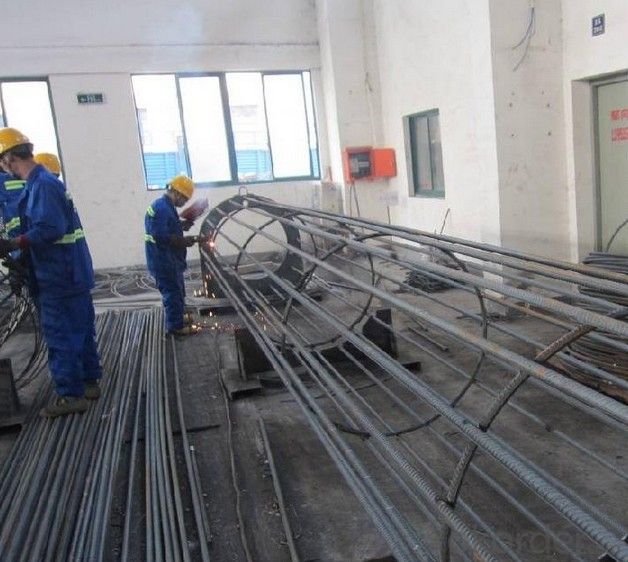


FAQ:
Q1: How do we guarantee the quality of our products?
A1: We have established an advanced quality management system which conducts strict quality tests at every step, from raw materials to the final product. At the same time, we provide extensive follow-up service assurances as required.
Q2: What makes stainless steel stainless?
A2: Stainless steel must contain at least 10.5 % chromium. It is this element that reacts with the oxygen in the air to form a complex chrome-oxide surface layer that is invisible but strong enough to prevent further oxygen from "staining" (rusting) the surface. Higher levels of chromium and the addition of other alloying elements such as nickel and molybdenum enhance this surface layer and improve the corrosion resistance of the stainless material.
- Q: How do steel rebars affect the structural capacity of concrete beams and columns?
- Steel rebars greatly enhance the structural capacity of concrete beams and columns. By reinforcing the concrete, rebars increase its tensile strength, allowing it to withstand greater loads and prevent cracking or failure. The combination of steel rebars and concrete creates a more robust and durable structure, ensuring its ability to bear heavy loads and withstand external forces.
- Q: Can steel rebars be used in structures with high resistance to fire?
- Yes, steel rebars can be used in structures with high resistance to fire. Steel has a high melting point and excellent fire resistance properties, making it a suitable choice for reinforcing structures that need to withstand high temperatures and fire hazards.
- Q: What are the factors that affect the strength of steel rebars?
- The strength of steel rebars can be affected by several factors. These factors include the composition of the steel bar, the manufacturing process used, the size and shape of the rebar, heat treatment processes, corrosion, and the loading conditions applied to the rebars. The composition of the steel bar is crucial in determining its strength. Steel rebars typically contain carbon, with a content ranging from 0.15% to 0.6%. This carbon content affects the hardness and strength of the rebar. Additionally, other elements such as manganese, silicon, and sulfur can also impact the rebar's strength. The manufacturing process used to produce the steel rebars can also influence their strength. Hot rolling is commonly employed, which involves heating the steel billets to high temperatures and shaping them by passing them through rollers. The cooling rate during this process can cause variations in the internal microstructure of the bar, resulting in differences in strength. The size and shape of the rebar are significant factors in determining its strength. Thicker and larger diameter rebars generally have higher strength capacities compared to thinner ones. Furthermore, the shape of the rebar, whether it is a plain round bar or has deformations like ribs, can also impact its strength. Heat treatment processes can be applied to steel rebars to enhance their strength. For example, quenching and tempering involve heating the rebar to a high temperature and then rapidly cooling it, increasing its strength and hardness. The specific heat treatment process used depends on the desired strength requirements. Corrosion can significantly reduce the strength of steel rebars over time. When exposed to moisture and oxygen, steel rebars can rust, leading to structural degradation. Proper corrosion protection measures, such as epoxy coating or galvanization, are essential for maintaining the strength and durability of the rebars. The type and magnitude of the applied loads also influence the strength of steel rebars. Different applications require rebars with varying strength capacities. Therefore, the design and engineering of structures should consider the expected loads to determine the appropriate strength of the rebars used. In conclusion, the strength of steel rebars is influenced by their composition, manufacturing process, size and shape, heat treatment, corrosion protection, and the loading conditions they will experience. It is crucial to consider these factors when selecting and using steel rebars in construction projects.
- Q: What are the different types of steel rebars available?
- There are several types of steel rebars available, including standard carbon steel rebars, epoxy-coated rebars, galvanized rebars, stainless steel rebars, and composite rebars.
- Q: Thread steel is embroidered after rain. Can it be used as reinforcing steel?
- There are two kinds of commonly used classification methods of thread steel: one is to shape classification, according to different space shapes and transverse rib rib for classification or type, such as the British Standard (BS4449), the thread steel is divided into type I and type ii. This classification mainly reflects the tightening performance of the threaded steel. The two is the performance of classification (class), for example, China's current implementation of standards, (G B1499.2-2007) for steel wire for 1499.1-2008), according to the strength (tensile strength yield point / steel) will be divided into 3 levels; the Japanese industrial standard (JI SG3112), according to the comprehensive performance of the steel branch for the 5 species; the British Standard (BS4461), also provides some level of performance test of thread steel. In addition, the thread steel can be classified according to the use, such as reinforced concrete, ordinary steel bars and reinforced concrete bars for heat treatment.
- Q: How do steel rebars affect the overall thermal stability of a structure?
- Steel rebars can significantly affect the overall thermal stability of a structure due to their thermal conductivity properties. Thermal stability refers to the ability of a structure to withstand changes in temperature without experiencing significant deformation or damage. Steel rebars have high thermal conductivity, which means they can efficiently transfer heat throughout a structure. This property can have both positive and negative effects on the thermal stability of the structure. On the positive side, steel rebars can help in dissipating heat from the structure, preventing the concentration of heat in specific areas. This can prevent localized thermal expansion, which can lead to cracks and structural failures. By evenly distributing heat, steel rebars can improve the overall thermal stability of the structure. On the negative side, steel rebars can also conduct heat to colder areas of the structure, leading to thermal gradients. This can result in differential expansion and contraction, causing stress and potential damage to the structure. Additionally, during fire incidents, steel rebars can rapidly heat up and transfer the heat to the surrounding concrete, reducing its strength and compromising the overall stability of the structure. To mitigate these potential negative effects, engineers and architects must carefully consider the design, placement, and spacing of steel rebars within the structure. By ensuring proper reinforcement layout and utilizing insulation materials, the thermal stability can be enhanced. Additionally, incorporating fire-resistant coatings or insulation around the rebars can help minimize the effects of heat transfer during fire incidents. In conclusion, steel rebars can significantly impact the overall thermal stability of a structure. While their high thermal conductivity can aid in dissipating heat, it can also lead to thermal gradients and potential damage. By carefully considering the design and incorporating appropriate measures, the negative effects of steel rebars on thermal stability can be minimized, ensuring the long-term durability and safety of the structure.
- Q: Can steel rebars be used in precast concrete?
- Yes, steel rebars can be used in precast concrete. Rebars provide reinforcement and strength to the concrete structure, making it more durable and resistant to cracking. They are commonly used in precast concrete elements such as beams, columns, and slabs to enhance their structural integrity.
- Q: Can steel rebars be used in residential construction?
- Yes, steel rebars can be used in residential construction. Steel rebars are commonly used as reinforcement in concrete structures, including residential buildings, to enhance their strength and durability.
- Q: Are steel rebars suitable for use in structures with high resistance to impact?
- Steel rebars are generally suitable for use in structures with high resistance to impact. Rebars, also known as reinforcement bars, are made from steel and are commonly used in concrete structures to enhance their strength and durability. Steel is known for its high tensile strength and ability to absorb and distribute impact forces, making it an ideal material for reinforcement. In structures that are prone to impact, such as bridges, highways, or buildings located in earthquake-prone areas, steel rebars play a critical role in providing additional strength and resistance. The use of rebars ensures that the structure can withstand sudden impact loads and prevent catastrophic failures. Moreover, steel rebars are available in various grades and sizes, allowing engineers to select the appropriate type of rebar based on the specific requirements of the structure. Higher grade rebars, such as Grade 60 or Grade 75, offer increased strength and ductility, making them even more suitable for structures with high resistance to impact. It is important to note that while steel rebars enhance the overall strength and impact resistance of a structure, other factors such as design, construction techniques, and maintenance also play vital roles in ensuring the structure's ability to withstand impact forces. Therefore, a comprehensive approach that considers all these factors is essential in designing and constructing structures with high resistance to impact.
- Q: Can steel rebars be used in historical monument conservation?
- Yes, steel rebars can be used in historical monument conservation. Steel rebars are commonly used in the restoration and strengthening of historical structures as they provide structural support and ensure the stability and longevity of the monument. However, it is essential to carefully analyze the impact of their installation on the historical value and authenticity of the monument. The use of steel rebars should be done in a way that minimizes any visual or aesthetic alterations to the monument, while still ensuring its preservation.
Send your message to us
A615 deformed steel bar deformed steel bar
- Loading Port:
- Tianjin
- Payment Terms:
- TT or LC
- Min Order Qty:
- 25 m.t.
- Supply Capability:
- 100000 m.t./month
OKorder Service Pledge
OKorder Financial Service
Similar products
Hot products
Hot Searches
Related keywords
